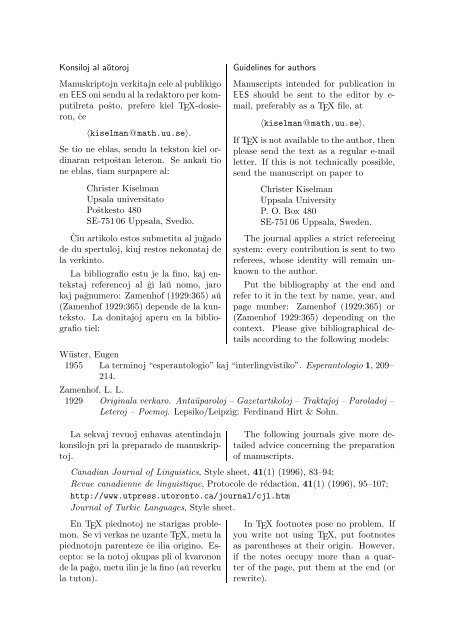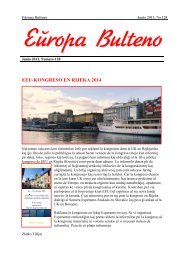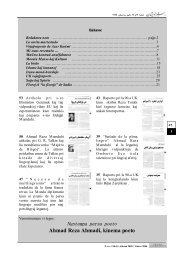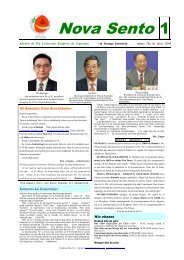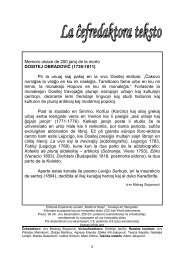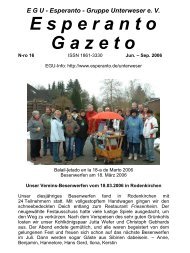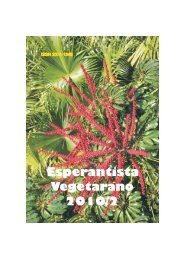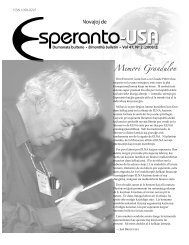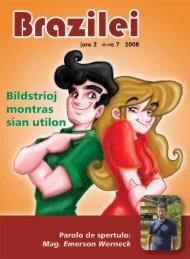ESPERANTOLOGIO ESPERANTO STUDIES - La Esperanta Gazetejo
ESPERANTOLOGIO ESPERANTO STUDIES - La Esperanta Gazetejo
ESPERANTOLOGIO ESPERANTO STUDIES - La Esperanta Gazetejo
You also want an ePaper? Increase the reach of your titles
YUMPU automatically turns print PDFs into web optimized ePapers that Google loves.
Konsiloj al aŭtoroj<br />
Manuskriptojn verkitajn cele al publikigo<br />
en EES oni sendu al la redaktoro per komputilreta<br />
poˆsto, prefere kiel TEX-dosieron,<br />
ĉe<br />
〈kiselman@math.uu.se〉.<br />
Se tio ne eblas, sendu la tekston kiel ordinaran<br />
retpoˆstan leteron. Se ankaŭ tio<br />
ne eblas, tiam surpapere al:<br />
Christer Kiselman<br />
Upsala universitato<br />
Poˆstkesto 480<br />
SE-751 06 Uppsala, Svedio.<br />
Ĉiu artikolo estos submetita al juˆgado<br />
de du spertuloj, kiuj restos nekonataj de<br />
la verkinto.<br />
<strong>La</strong> bibliografio estu je la fino, kaj entekstaj<br />
referencoj al ˆgi laŭ nomo, jaro<br />
kaj paˆgnumero: Zamenhof (1929:365) aŭ<br />
(Zamenhof 1929:365) depende de la kunteksto.<br />
<strong>La</strong> donitaˆjoj aperu en la bibliografio<br />
tiel:<br />
Guidelines for authors<br />
Manuscripts intended for publication in<br />
EES should be sent to the editor by email,<br />
preferably as a TEX file, at<br />
〈kiselman@math.uu.se〉.<br />
If TEX is not available to the author, then<br />
please send the text as a regular e-mail<br />
letter. If this is not technically possible,<br />
send the manuscript on paper to<br />
Christer Kiselman<br />
Uppsala University<br />
P. O. Box 480<br />
SE-751 06 Uppsala, Sweden.<br />
The journal applies a strict refereeing<br />
system: every contribution is sent to two<br />
referees, whose identity will remain unknown<br />
to the author.<br />
Put the bibliography at the end and<br />
refer to it in the text by name, year, and<br />
page number: Zamenhof (1929:365) or<br />
(Zamenhof 1929:365) depending on the<br />
context. Please give bibliographical details<br />
according to the following models:<br />
Wüster, Eugen<br />
1955 <strong>La</strong> terminoj “esperantologio” kaj “interlingvistiko”. Esperantologio 1, 209–<br />
214.<br />
Zamenhof, L. L.<br />
1929 Originala verkaro. Antaŭparoloj – Gazetartikoloj – Traktaˆjoj – Paroladoj –<br />
Leteroj – Poemoj. Lepsiko/Leipzig: Ferdinand Hirt & Sohn.<br />
<strong>La</strong> sekvaj revuoj enhavas atentindajn<br />
konsilojn pri la preparado de manuskriptoj.<br />
The following journals give more detailed<br />
advice concerning the preparation<br />
of manuscripts.<br />
Canadian Journal of Linguistics, Style sheet, 41(1) (1996), 83–94;<br />
Revue canadienne de linguistique, Protocole de rédaction, 41(1) (1996), 95–107;<br />
http://www.utpress.utoronto.ca/journal/cjl.htm<br />
Journal of Turkic <strong>La</strong>nguages, Style sheet.<br />
En TEX piednotoj ne starigas problemon.<br />
Se vi verkas ne uzante TEX, metu la<br />
piednotojn parenteze ĉe ilia origino. Escepto:<br />
se la notoj okupas pli ol kvaronon<br />
de la paˆgo, metu ilin je la fino (aŭ reverku<br />
la tuton).<br />
In TEX footnotes pose no problem. If<br />
you write not using TEX, put footnotes<br />
as parentheses at their origin. However,<br />
if the notes occupy more than a quarter<br />
of the page, put them at the end (or<br />
rewrite).


